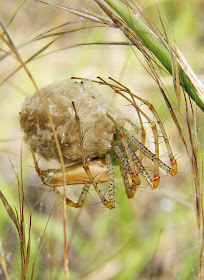Around Halloween, spider webs are not just artificial
decorations around human homes but a very obvious part of the natural world. Many big spiders seem
to mature at a time when most insects are close to the end of their lives. In autumn the spiders can easily harvest weakened
bees, beetles and grasshoppers that might have been able to put up too much of
a struggle in their prime. This
abundance of prey provides spiders with resources to survive the lean winter months. The term survival doesn't refer to the individual here. Many spiders mature and produce eggs in autumn, and it is often only the
offspring that winters, be it in form of eggs or as freshly hatched
spiderlings. But it certainly pays to send these off very well nourished.
 |
| Peucetia viridans (Green Lynx Spider) preying on a bee |
Their translucent green color of Peucetia viridans (Green Lynx Spider) may be cryptic enough to
hide them from their prey when they lay in ambush on green foliage. But when they stalk their prey on flowers as they very often do, they seem very obvious
at least to the human eye and far less camouflaged than the yellow and white crab spiders
that are also hunting for flower visitors.
By late October the female lynx spiders reach maturity and are quite big, three fourth of an inch. They produce a ball of webbing that is about the size of a quarter and suspended from tall grasses or twigs of a mesquite or acacia.
The ball is the egg sac of the spider that she guards carefully. It contains hundreds of eggs Interestingly, in this case there was also silk-wrapped prey, namely a honey bee, in this nesting area. I wonder whether the female, duty-bound to the nest as she is, is now routinely trapping insects for food, or whether she just opportunistically collects when something gets caught. Are any of the threads sticky? I think I have to research what is known about the phylogenesis of spider webs as traps. Maybe they did all evolve from nesting webs which are not uncommon among arthropods.
This spider
is guarding her freshly hatched spiderlings in the mesquite grassland around
Molino Basin. Bynow her egg sack is loosing its tightly woven coherence.
Hundreds of young spiders will soon be pouring out of this one egg sack. It looks as if they go through one molt before they move on, as many exuviae are still hanging in the nest.
By mid November the kids have grown and the female has lost a lot of weight.
 |
| Peucetia viridans (Green Lynx Spider) with hatchlings, photo added in Nov. 2014 |
 |
| Juvenile wolf spider ready for take-off (photo by Pieceoflace Photohraphy) |
Instead, like dandelion seeds, many young spiders use aerial navigation: Each spider climbs the top of a grass or a twig. Here the spider lifts up its abdomen and spins out a thread, long enough to buoy up the spider. A mild upward air current of a still autumn day would be ideal to carry the silk and the attached little spider far enough to begin her live on her own. New research even suggests that earth electromagnetic fields or more localized electromagmetic phenomena may help explain why aerial navigation can take place on windless days.
 |
| Gossamer Sunset (photo by DavidMXGreen@gmail.com) |
Threads of
millions of little spider floating in the wind can form showers of silvery gossamer. If they all get caught in the same area they can form veils that cover soil and vegetation in magically sparkling layers. In Germany this time of the year is called Altweibersommer, 'old wives' summer for its flying silvery threads.






What I've always wondered is: where do the baby lynxes disappear to over the winter? I never see them again until spring. Are they hibernating somewhere?
ReplyDeleteVery kool pictures as usual and simply put in terms which will intrigue and capture the attention and interest of most novices to this world where they would be otherwise put off. Very well done Margarethe.
ReplyDelete